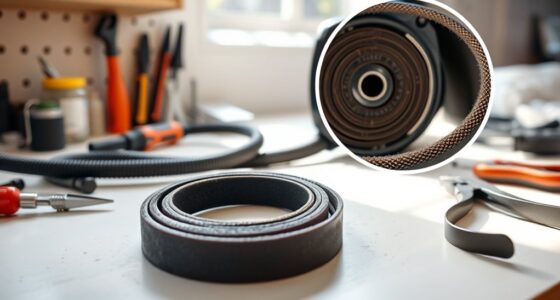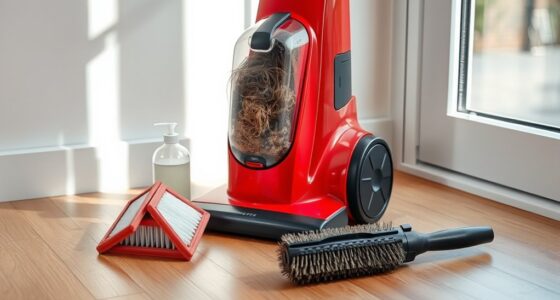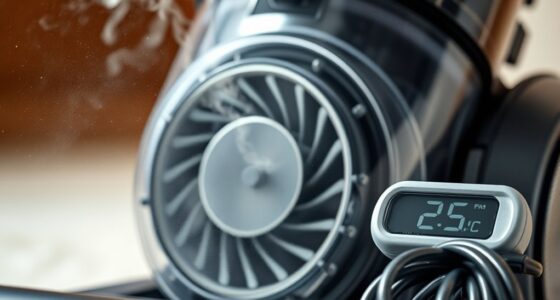When vacuuming fine dust, avoid common mistakes that can lead to clogs. Use specialized vacuums designed for fine particles and clean your filters regularly to maintain suction power. Consider adding pre-filters to catch larger debris before they reach the main filter, and manage airflow to help heavier particles settle. Regularly check for blockages in hoses and attachments to guarantee efficient operation. Want to know more tips to enhance your vacuuming experience?
Key Takeaways
- Use specialized vacuums designed for fine dust to enhance filtration and reduce clogging risks.
- Regularly clean or replace vacuum filters to maintain optimal airflow and suction power.
- Employ pre-filters to capture larger particles before they reach the main filter.
- Monitor suction power frequently and check for blockages in hoses and attachments.
- Remove hair and lint from the brush roll to ensure uninterrupted airflow during vacuuming.
Common Mistakes When Vacuuming Fine Dust
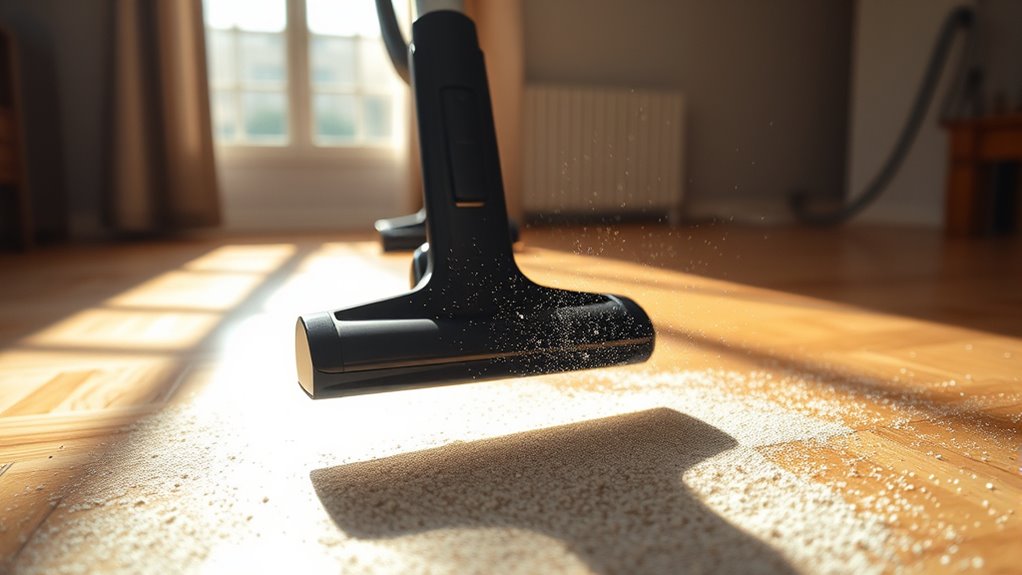
When you vacuum fine dust, it’s easy to overlook some common mistakes that can lead to reduced performance. One major error is attempting to clean heavily powdered surfaces, which can quickly clog your vacuum’s filtration system.
Even small amounts of fine dust can overwhelm it, reducing your vacuum’s suction power considerably. Additionally, using your vacuum on construction or craft debris can cause serious clogs and impair its function.
To prevent these issues, follow some simple maintenance tips: regularly check and clean your filters to guarantee ideal airflow. Consider using specialized vacuum attachments designed for fine dust to enhance your cleaning efficiency while minimizing clog risks.
The Importance of Regular Filter Maintenance
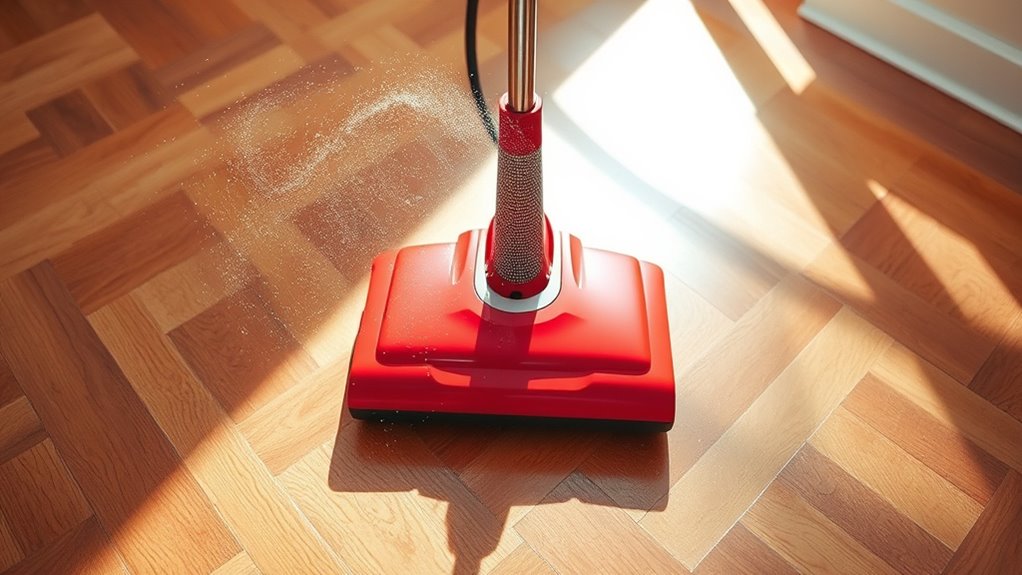
Keeping your vacuum filters clean is essential for maintaining peak performance. You should wash them monthly or replace them when they show signs of clogging to guarantee your vacuum runs efficiently.
Ignoring filter maintenance can lead to reduced suction and a shorter lifespan for your machine.
Filter Cleaning Frequency
Regularly cleaning your vacuum’s filters is essential for maintaining its performance. A proper filter cleaning frequency not only guarantees peak suction but also extends your vacuum’s lifespan.
Here are some tips to keep in mind:
- Wash filters monthly: Follow the manufacturer’s instructions for washing your vacuum filters regularly to prevent clogged filters.
- Replace bagged filters: Change filters in bagged vacuums every 2-4 months to maintain effective airflow.
- Inspect for damage: Regularly check your vacuum filters for wear and tear to avoid decreased efficiency.
- Utilize self-cleaning options: If your vacuum has self-cleaning or disposable filters, take advantage of these features for easier maintenance.
Signs of Clogging
Neglecting your vacuum filters can lead to noticeable signs of clogging that affect performance. You might notice a significant reduction in suction power, making it harder to pick up dirt and debris.
If your vacuum struggles to maintain airflow, it’s a clear indication that the filters are clogged. Accumulated dust not only hampers suction but can also cause your vacuum to work harder, increasing wear on internal components. Using a vacuum with high suction power can significantly improve your cleaning efficiency. Regular maintenance of your vacuum is essential, similar to how home security systems require periodic checks to ensure optimal performance.
Regularly inspecting and cleaning your filters each month is vital; otherwise, they could become difficult to clean over time. Additionally, using a vacuum with advanced filtration systems can help capture allergens effectively and maintain optimal performance.
Replacement Guidelines
While it’s easy to forget about vacuum filters, staying on top of their maintenance is essential for your vacuum’s performance.
To guarantee your vacuum runs efficiently, follow these replacement guidelines:
- Clean filters monthly: Regular washing according to the manufacturer’s instructions keeps airflow efficient.
- Replace filters annually: Doing this prevents clogging that hinders suction.
- Change bags in bagged vacuums: Aim for a replacement every 2-4 months to maintain peak suction.
- Check self-cleaning filters: Even these need regular inspection to verify they’re functioning properly.
Neglecting these maintenance tasks can lead to reduced efficiency, increased wear and tear, and a shorter lifespan for your vacuum.
Stay proactive to keep your vacuum performing at its best!
Utilizing Pre-Filters for Enhanced Dust Collection
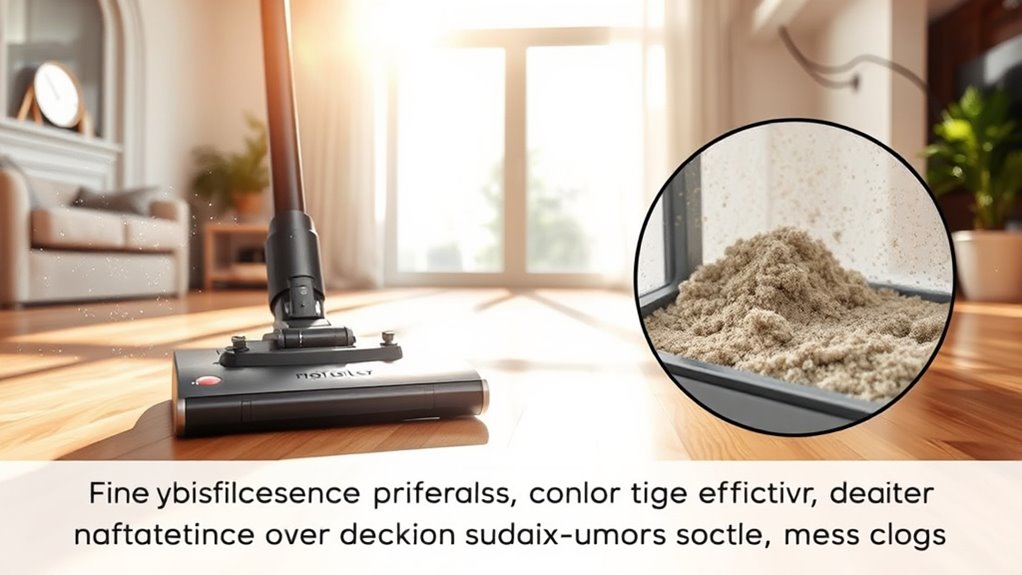
Utilizing pre-filters can considerably enhance your dust collection efforts, as they capture larger particles before they reach the main filter. Options like a lady’s hose or foam cover effectively extend the main filter’s lifespan and minimize clogging.
Installing a Dust Deputy as a pre-filter boosts particle separation, letting finer dust get captured while keeping the main filter from overloading. For specific dust types, using inter bags can provide an extra layer of filtration, enhancing overall efficiency.
Enhancing filtration with a Dust Deputy and inter bags improves dust capture and protects your main filter from overload.
Additionally, setting up a closed 55-gallon drum between your vacuum and collection head helps slow airflow, allowing heavier particles to drop out.
Finally, regularly switching between multiple filters guarantees consistent performance and reduces downtime related to filter maintenance, keeping your vacuum running smoothly.
Airflow Management Techniques for Vacuum Efficiency
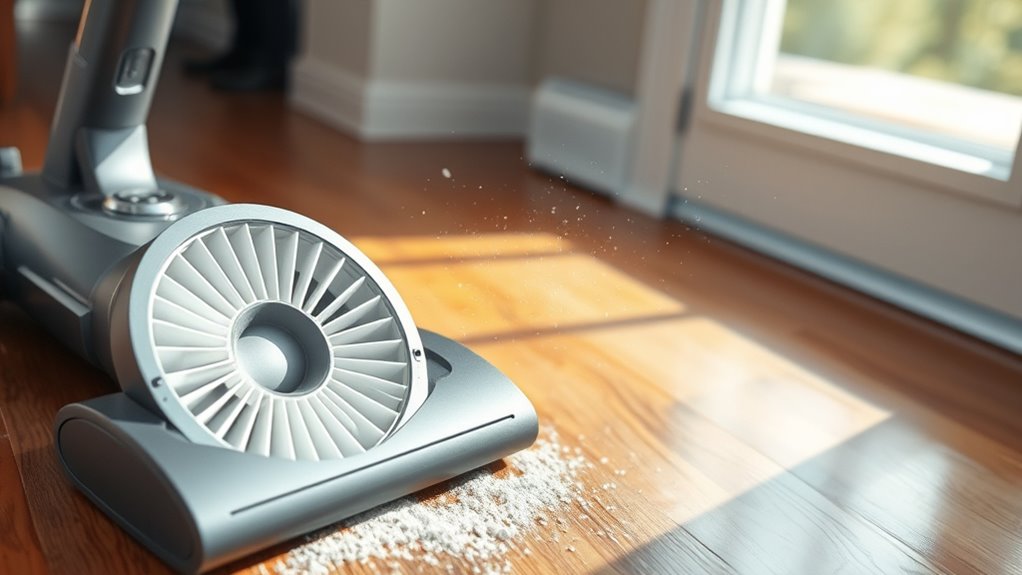
To boost your vacuum’s efficiency, managing airflow is essential.
Slowing down the airflow can help larger dust particles settle before they hit the filter, while adding pre-filters can catch debris and extend filter life.
Implementing these strategies not only reduces clogging but also enhances overall suction performance.
Slow Airflow Strategy
Effective airflow management is essential for maintaining vacuum efficiency, especially when you want to prevent clogs and extend filter life. A slow airflow strategy can be incredibly beneficial.
Here are some techniques to enhance your vacuum performance:
- Utilize a closed 55-gallon drum: This helps separate larger particles from fine dust before they reach the filter.
- Incorporate coarse nylon mesh: It breaks up airflow, allowing heavier debris to settle out, reducing clog risks.
- Adopt practices from ultrafine powder handling: These can greatly boost both suction efficiency and filter longevity.
- Regularly apply airflow techniques: This helps extend the life of your filters and minimizes the need for frequent cleaning or replacements.
Pre-Filter Installation Options
Airflow management doesn’t stop with slow airflow strategies; pre-filter installation options further enhance vacuum efficiency.
One effective method is installing a pre-filter foam cover around your main filter. This traps dust particles before they reach the filter, extending its lifespan and maintaining suction.
You might also consider using a lady’s hose over the filter, acting as a barrier against larger particles. If you’re using shop vacs, placing a closed 55-gallon drum between the vacuum and collection head can help larger debris settle out, minimizing clogs.
Additionally, implementing a Dust Deputy cyclone separator improves particle separation, boosting overall performance.
Finally, regularly switching between multiple filters guarantees your internal components remain clean, keeping suction levels ideal.
Effective Dust Settling Techniques
Dust can be a persistent challenge when vacuuming, but mastering effective settling techniques can greatly improve your vacuum’s performance. By managing airflow, you can prevent clogs and maintain suction.
Here are some techniques to try:
- Slow Airflow: Reducing airflow allows dust to settle before reaching the filter, minimizing clogging.
- Closed Container: Use a 55-gallon drum to catch larger particles before they hit your vacuum’s filter.
- Coarse Mesh: Incorporate a coarse nylon mesh to disrupt airflow, preventing fine dust from clogging the filter.
- Wet/Dry Vacuum: Adding water can effectively trap fine dust, keeping it suspended and away from the filter.
Implementing these techniques will enhance your vacuum’s efficiency and prolong the life of your filter.
Best Practices for Vacuuming Fine Powders
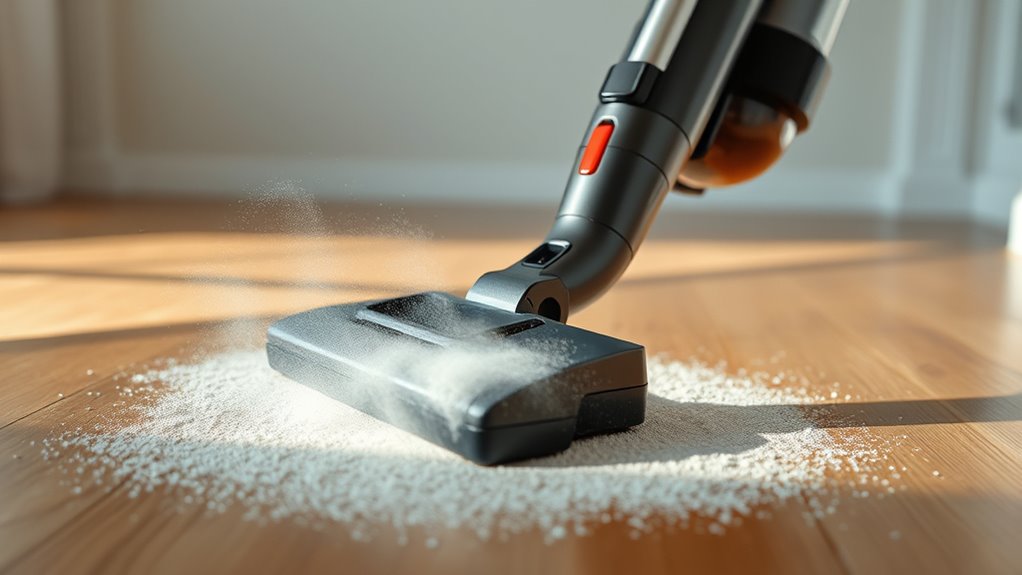
When vacuuming fine powders, you should take extra precautions to prevent clogs and maintain your vacuum’s effectiveness. Avoid using a regular vacuum cleaner for materials like baking soda, as they can easily clog filters. Instead, opt for vacuums designed for fine dust, featuring advanced filtration systems. Regularly clean or replace your filters according to the manufacturer’s instructions.
Here’s a quick reference table for best practices:
| Best Practices | Benefits | Additional Tips |
|---|---|---|
| Use specialized vacuums | Reduces clogging | Look for water-based filtration |
| Clean filters regularly | Guarantees ideal airflow | Follow manufacturer guidelines |
| Utilize pre-filters | Catches fine particles early | Consider disposable options |
| Avoid fine powders | Prevents damage to vacuum parts | Use alternatives when possible |
| Monitor suction power | Maintains vacuum efficiency | Check for blockages frequently |
Maintaining Suction Power for Optimal Performance
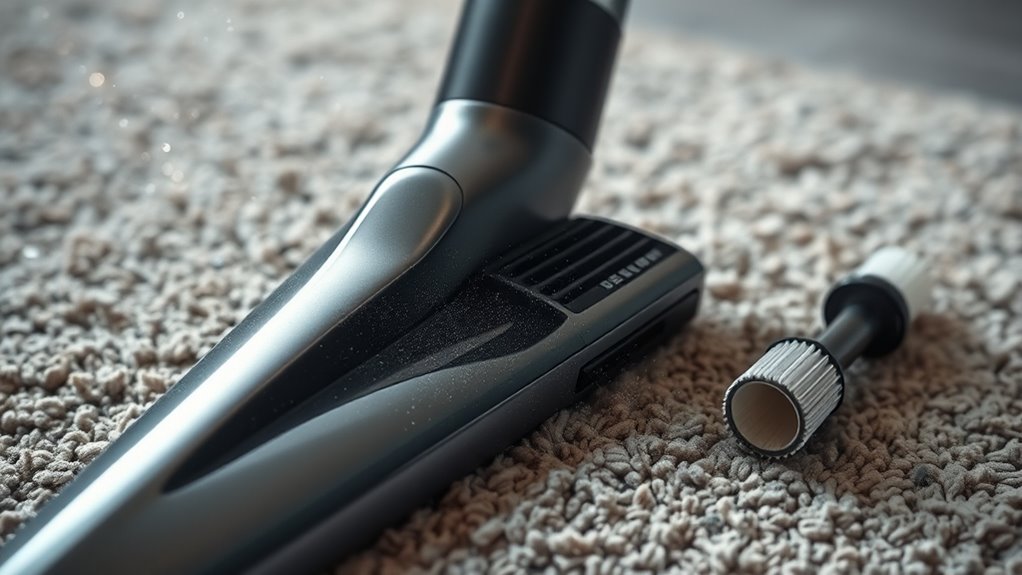
To maintain ideal suction power, it’s crucial to regularly empty your vacuum’s dust bin or replace the bag. Full containers restrict airflow, leading to reduced performance.
Here are some key tips for maintaining suction power:
- Clean or replace filters: Follow the manufacturer’s guidelines to guarantee maximum airflow. Using a HEPA filter can significantly improve the vacuum’s ability to capture fine particles.
- Inspect hoses and attachments: Check for blockages and verify all connections are sealed to maximize suction efficiency.
- Remove hair and lint from the brush roll: This prevents debris from impeding airflow and straining the motor.
- Utilize water in wet/dry vacuums: This method captures fine dust and reduces filter maintenance frequency. Additionally, using a filtration system can significantly enhance the vacuum’s ability to capture allergens and fine dust.
Frequently Asked Questions
Can I Vacuum Fine Dust?
You shouldn’t vacuum fine dust unless you’re sure your vacuum can handle it. Fine powders can clog filters and reduce suction, which might lead to motor damage.
If your vacuum’s designed for such materials, you might be able to use it cautiously. Just remember to keep up with regular maintenance, like cleaning or replacing filters, to avoid problems.
It’s best to choose a vacuum that specializes in handling fine dust for peak results.
How to Keep a Vacuum From Clogging?
To keep your vacuum from clogging, regularly check and clean the filters as instructed by the manufacturer.
Make sure to empty the dustbin or replace bags frequently to maintain peak suction power.
Use attachments specifically designed for different tasks to capture debris effectively.
Additionally, consider using pre-filters to catch larger particles before they reach the main filter, which helps extend its life and prevent clogs.
Regular maintenance can make a big difference!
How Can I Improve the Suction on My Vacuum?
To improve the suction on your vacuum, start by emptying the dustbin or replacing the vacuum bag regularly.
Clean or change the filters according to the instructions, as clogged filters can hinder suction.
Check the brush roll for tangled hair and debris, and remove any blockages.
Finally, inspect all connections for leaks; even small gaps can drastically reduce suction.
Keeping these components in top shape will enhance your vacuum’s performance.
Why Should You Avoid Sweeping up Fine Dust?
Why should you avoid sweeping up fine dust? Because it can clog your vacuum and reduce its suction power.
Fine particles can overwhelm your vacuum’s filtration system, leading to blockages that not only hinder performance but also shorten your vacuum’s lifespan.
You’ll end up releasing dust back into the air instead of cleaning it up.
Conclusion
By keeping these tips in mind, you can turn your vacuum into a dust-busting superhero. Regular maintenance, smart airflow management, and utilizing pre-filters will guarantee your vacuum retains its mighty suction. Remember, fine dust doesn’t stand a chance when you’re armed with the right techniques. So, roll up your sleeves, and make every cleaning session count. With a little care, you’ll keep your home spotless and your vacuum running like a dream!



